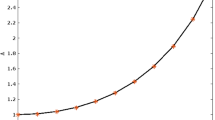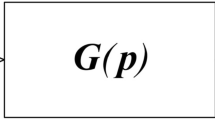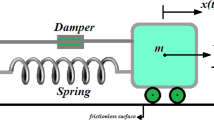Abstract
In this article, an effective technique is developed to efficiently obtain the output responses of parameterized structural dynamic problems. This technique is based on the conception of reduced basis method and the usage of linear interpolation principle. The original problem is projected onto the reduced basis space by linear interpolation projection, and subsequently an associated interpolation matrix is generated. To ensure the largest nonsingularity, the interpolation matrix needs to go through a timenode choosing process, which is developed by applying the angle of vector spaces. As a part of this technique, error estimation is recommended for achieving the computational error bound. To ensure the successful performance of this technique, the offline-online computational procedures are conducted in practical engineering. Two numerical examples demonstrate the accuracy and efficiency of the presented method.
Similar content being viewed by others
References
Liu, G.R., Quek, S.S.: Finite Element Method: A Practical Course. Butterworth-Heinemann Press, Oxford (2003)
Yan, X.Q.: Finite element modeling of consolidation of composite laminates. Acta Mech. Sin. 22(1), 62–67 (2006)
Semblat, J.F., Duval, A. M., Dangla, P.: Modal Superposition Method for the analysis of seismic-wave amplification. Bull. Seismol. Soc. Am. 93(3), 1144–1153 (2003)
Festa, G., Vilotte, J.P.: The Newmark method as velocity-stress time-staggering: an efficient PML implementation for spectral element simulations of elastodynamics. Geophys. J. Int. 161(3), 789–812 (2005)
Ozkul, T.A.: A finite element formulation for dynamic analysis of shells of general shape by using the Wilson-θ method. Thin Wall. Struct. 42(4), 497–513 (2004)
Proakis, J.G., Manolakis, D.G.: Digital Signal Processing. Prentice Hall Press, Upper Saddle River (2006)
Mermer, C., Kim, D., Kim, Y.: Efficient 2D FFT implementation on mediaprocessors. Parallel Comput. 29(6), 691–709 (2003)
Huang, H.Y., Lee, Y.Y., Lo, P.C.: A novel algorithm for computing the 2D split-vector-radix FFT. Signal Process. 84(3), 561–570 (2004)
Prud’homme, C., Rovas, D.V., Veroy, K., et al.: Reliable real-time solution of parametrized partial differential equations: reduced-basis output bound methods. J. Fluid Engrg. 124(1), 70–80 (2002)
Veroy, K.: Reduced-basis methods applied to problems in elasticity analysis and application, [Ph.D. Thesis], MIT, America (2003)
Rozza, G.: Reduced-basis methods for elliptic equations in sub-domains with a posteriori error bounds and adaptivity. Appl. Numer. Math. 55(4), 403–424 (2005)
Huang, Y.H., Han, X., Ran, C.X.: Efficient method for transient analysis in laminated plates based on reduced-basis method. Acta Mech. Sin. 40(2), 255–260 (2008) (in Chinese)
Rozza, G., Huynh, D.B.P., Patera, A.T.: Reduced basis approximation and a posteriori error estimation for affinely parametrized elliptic coercive partial differential equations: application to transport and continuum mechanics. Arch. Comput. Methods Eng. 15(3), 229–275 (2008)
Nguyen, N.C.: A multiscale reduced-basis method for parametrized elliptic partial differential equations with multiple scales. J. Comput. Phys. 227(23), 9807–9822 (2008)
Patera, A.T., Rønquist, E.M.: Reduced basis approximation and a posteriori error estimation for a Boltzmann model. Comput. Methods Appl. Mech. Engrg. 196(29–30), 2925–2942 (2007)
Milani, R., Quarteroni, A., Rozza, G.: Reduced basis method for linear elasticity problems with many parameters. Comput. Methods Appl. Mech. Engrg. 197(51–52), 4812–4829 (2008)
Liu, G.R., Lee, J.H., Patera, A.T., et al.: Inverse identification of thermal parameters using reduced-basis method. Comput. Methods Appl. Mech. Engrg. 194(27–29), 3090–3107 (2005)
Ito, K., Ravindran, S.S.: A reduced-order method for simulation and control of fluid flows, J. Comput. Phys. 143(2), 403–425 (1998)
Zaw, K., Liu, G.R., Deng, B., et al.: Rapid identification of elastic modulus of the interface tissue on dental implants surfaces using reduced-basis method and a neural network, J. Biomech. 42(5), 634–641 (2009)
Kapania, R.K., Byun, C.: Reduction methods based on eigenvectors and Ritz vectors for nonlinear transient analysis. Comput. Mech. 11(1), 65–82 (1993)
Krysl, P., Lall, S., Marsden, J.E.: Dimensional model reduction in non-linear finite element dynamics of solids and structures. Int. J. Numer. Methods Engrg. 51(4), 479–504 (2001)
Deraemaeker, A., Ladeveze, P., Leconte, P.: Reduced basis for model updating in structural dynamics based on constitutive relation error. Comput. Methods Appl. Mech. Engrg. 191(21–22), 2427–2444 (2002)
Cheney, W., Light, W.: A Course in Approximation Theory. Brooks/Cole Publishing Company, California, America (2000)
Liefvendahl, M., Stocki, R.: A study on algorithms for optimization of Latin hypercubes. J. Stat. Plann. Infer. 136(9), 3231–3247 (2006)
Ye, K.Q., Li, W., Sudjianto, A.: Algorithmic construction of optimal symmetric Latin hypercube designs. J. Stat. Plann. Infer. 90(1), 145–159 (2000)
Author information
Authors and Affiliations
Corresponding author
Additional information
The project was supported by the National Natural Science Foundation of China (10802028), the Major State Basic Research Development Program of China (2010CB832705) and the National Science Fund for Distinguished Young Scholars (10725208).
Rights and permissions
About this article
Cite this article
Zhang, Z., Han, X. & Jiang, C. An efficient technique for recovering responses of parameterized structural dynamic problems. Acta Mech Sin 27, 757–766 (2011). https://doi.org/10.1007/s10409-011-0448-0
Received:
Revised:
Accepted:
Published:
Issue Date:
DOI: https://doi.org/10.1007/s10409-011-0448-0




